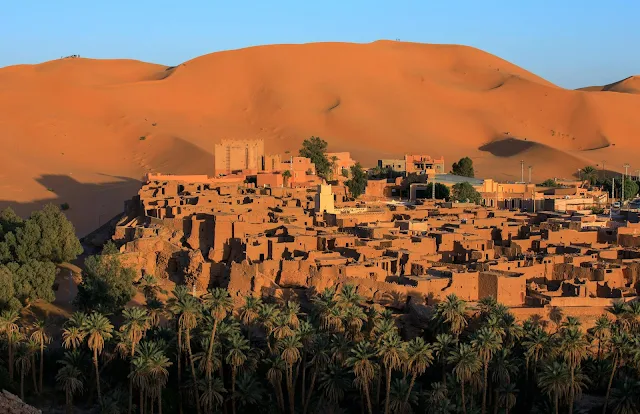Algiers, the capital of Algeria, unfolds like a palimpsest. Every corner whispers tales of conquest, resistance, and rebirth. It’s a city where French colonial boulevards rub shoulders with Ottoman minarets and where the Casbah—a UNESCO World Heritage site—still pulses with daily life, despite centuries of change. This place doesn’t merely invite you to observe; it dares you to feel.
The Heartbeat of the Casbah
My first real encounter with Algiers began in its oldest quarter: the Casbah. More than just a neighborhood, it’s the city’s historical soul. Walking its narrow, labyrinthine alleys felt like drifting through time. Children played football in shadowed courtyards while old men brewed strong mint tea beneath faded, tiled archways. Women leaned from their carved wooden balconies, their chatter weaving through the air with the calls to prayer echoing from nearby mosques.
As I meandered deeper, guided by the scent of grilled merguez sausage and baking khobz el dar, I found myself outside the Ketchaoua Mosque. Originally built in the 17th century and later transformed into a cathedral during the French occupation, it has since returned to its roots. Its stone walls seem to carry the collective memory of an entire people.
“Here,” my local guide told me, “the stones remember.” I believed him.
Between Sea and Sky
To see Algiers from above is to understand it. The city spills from the heights of the Casbah down to the coastline like an amphitheater facing the sea. I spent an afternoon wandering along the Boulevard Che Guevara, once the Boulevard de la République. The scent of saltwater clung to the air as fishing boats bobbed gently in the Port of Algiers.From here, I boarded the Téléphérique d’Alger—a cable car that glides above the city rooftops—to reach the heights of Notre-Dame d’Afrique. This 19th-century basilica, an architectural echo of its sister in Marseille, is a serene spot to take in a sunset over the bay. Below, the white facades of Algiers blushed pink with the fading light.
Flavors of the Maghreb
If the soul of Algiers is found in the Casbah, then its joy lives in the food. I spent a long afternoon at a modest café near Place des Martyrs, where I ordered rechta—thin noodles drenched in a light chicken and turnip sauce, delicately spiced with cinnamon. Another day brought me to a family-run restaurant where I tasted chakhchoukha, torn semolina bread soaked in a tomato-meat sauce, rich with cumin and coriander.
Fresh mint tea, poured from extravagant heights into slender glass cups, accompanied every meal. But it was the pastries that lingered in memory: makrout dripping with honey, almond-stuffed gazelle horns, and date-filled bradj perfumed with orange blossom.
Food in Algiers isn’t just sustenance. It’s a history lesson—centuries of Berber, Arab, Ottoman, and French influence simmered down into bite-sized traditions.
Echoes of History
There is no understanding Algiers without reckoning with its colonial past. The city's architecture is haunted by it. Walking through the city center, I passed beneath Haussmann-style facades and beneath the iron balconies of buildings that once housed French administrators.At the Museum of the National Struggle for Independence, located in a former prison, the silence inside is heavier than words. It was here that I truly felt Algeria’s fierce spirit. “Freedom,” read an inscription on one wall, “was never given—it was taken.”
Algiers has a complicated beauty, one forged in resistance and resilience.
Practical Tips for Exploring Algiers
Travel tips for Algeria often focus on logistics, but Algiers deserves more than a checklist. Still, it’s helpful to know a few things.
French is widely spoken, and while Arabic is the official language, many locals will greet you in a mixture of both. Dress modestly, particularly in the Casbah or religious sites, and be prepared for warm hospitality—often in the form of mint tea and unsolicited storytelling.
Public transportation is affordable and efficient, though the cable car rides offer some of the most scenic views. If you’re short on time, focus on the Casbah, Martyrs’ Memorial (Maqam Echahid), the Bardo Museum, and a sunset walk along the corniche.
And yes, street food is safe—especially if it smells as good as it looks.
Why Visit Algiers?
Why visit Algiers? Because it’s unlike anywhere else in North Africa—or the world. It is not as polished as Paris, nor as touristy as Marrakech. Instead, it feels honest. Tangible. Alive.It’s a place where time folds in on itself, where Ottoman palaces meet brutalist modernist structures, and where a market vendor might quote poetry between bargaining over spices. Algiers is not an easy city, but it is a real one.
And perhaps that’s its greatest gift: it doesn’t try to charm you. It simply is, and it waits for you to meet it on its own terms.
Final Thoughts
On my last evening in Algiers, I sat on a bench overlooking the sea, watching the horizon melt into darkness. A cool breeze stirred, carrying with it the faint scent of jasmine and grilled lamb from a nearby vendor.
Algiers doesn’t shout its wonders—it whispers them. You must listen closely, feel deeply, and walk slowly. Because once it gets under your skin, it never leaves.
Come with curiosity and leave room for wonder. The city will do the rest.
Keywords:
best places to visit in Algeria, travel tips for Algiers, why visit Algiers, Algiers Casbah travel, food in Algeria, cultural travel Algeria, Algiers itinerary, exploring Algiers
Let me know if you'd like this formatted for Blogger or converted to PDF.




Comments
Post a Comment
Thanks for coming by. We will come back to you soon :)